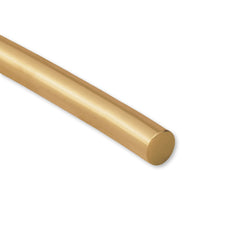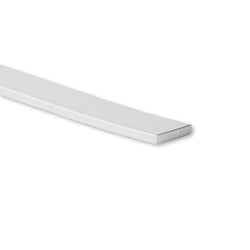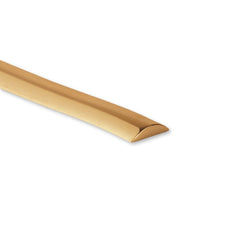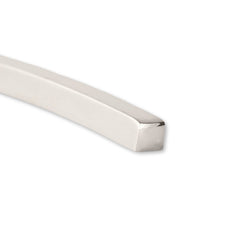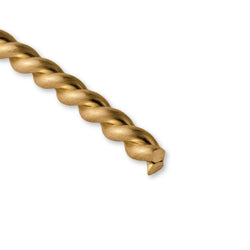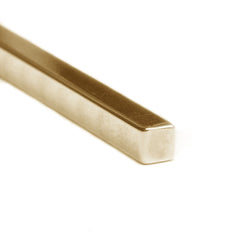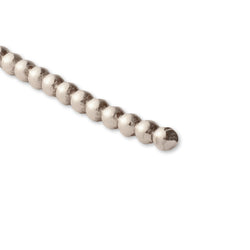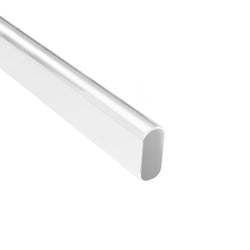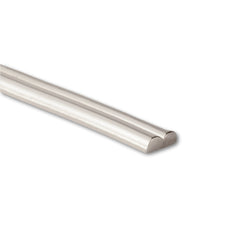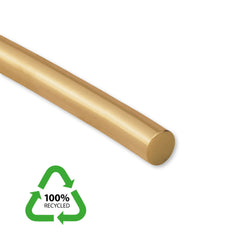Smycketråd
Metalltråd är ett kärnmaterial i juvelerarens hantverk. På Ore Metals har vi utvecklat vårt omfattande trådsortiment för att inkludera flera former och hårdhetsalternativ. Vår populära runda tråd i sterling silver finns i 20 olika storlekar från 0,2 mm (30 gauge) till 5 mm (4 gauge).
Från mångsidigt silver till klassiskt guld och skräddarsydd platina, vi köper förstklassiga australiensiska metaller för att ge den ultimata kvaliteten inom smyckenstillverkning . Bläddra i vårt otroliga utbud och bli inspirerad!
Solid ädelmetall smycken gör tråd
Oavsett om dina smyckenstillverkningsbehov kräver rund tråd för att tillverka hoppringar, rektangulär tråd för intrikat stämplingsarbete eller halvrund tråd skräddarsydd för skräddarsydda stensättningar, är vårt omfattande urval här för att möta dina behov. Vi erbjuder ett varierat utbud av legeringar, allt från 9 karat vitguld till 18 karat roséguld och alla varianter däremellan. Upptäck den exakta storleken och formen som krävs för att perfekta din design idag.
Vanliga frågor
Jewellery wire is a thin, flexible strand of metal used in various jewellery-making applications, including wire wrapping, beading, and forming components like frames, ring bands, jump rings and much more. It is available in various metals, such as silver, gold, and copper, and comes in different shapes (round, square, half-round, rectangular, beaded) and hardness levels (dead soft, half-hard, full-hard).
The best wire for jewellery depends on the type of project. For general wire wrapping and silversmith / goldsmith applications, sterling silver or solid gold wire is popular due to its durability and aesthetic appeal. Copper wire is an excellent choice for beginners because it's affordable and easy to work with. For intricate designs, dead soft or half-hard wire is typically preferred.
Jewellery wire is often referred to by its metal type and shape (e.g., sterling silver rectangular wire, 9ct yellow gold round wire). It may also be categorised by its hardness (dead soft, half-hard, full-hard)
The best gauge wire for jewellery making depends on the project. Common gauges are 18 to 24 gauge:
18-gauge: Strong and ideal for creating sturdy components like jump rings and clasps.
20-gauge: Versatile, used for earring wires, headpins, and medium-weight wire wrapping.
24-gauge: Thinner and more flexible, great for fine wire wrapping, intricate designs, and working with smaller beads.
Jewellery wire can be used in a variety of ways, such as wrapping it around gemstones, beads, or other components to create wire-wrapped designs. It can also be twisted, shaped, and bent into intricate patterns, loops, or frames. Additionally, it is used to make jump rings, clasps, and other functional components in jewellery-making. Jewellery wire is a versatile workhorse in the world of jewellery making supplies. It serves as both the backbone for structural components and the creative foundation for crafting custom-made elements, making it an essential tool for artisans of all levels.
Jewellery wire can be joined using several methods:
Soldering: Ideal for a strong, permanent connection.
Twisting or Wrapping: Common in wire wrapping, where wires are twisted or coiled around each other.
Using Crimp Beads or Tubes: Often used in beading, where the wire is crimped to secure it in place.
Clasps: Combined with soldering, wire ends can be attached to pre-made clasps
Jewellery wire can be used to create a wide range of items, including:
-Wire-wrapped pendants and rings
-Beaded bracelets and necklaces
-Custom earring hooks and findings
-Decorative elements like spirals, coils, and filigree
-Chain links and clasps
To straighten jewellery wire, you can gently pull it through your fingers or use nylon-jawed pliers to avoid marring the surface. Apply soft even pressure on the opposing edge of kinks or bends.
For making rings, 16-gauge, 18-gauge or 20-gauge wire is generally preferred. These gauges offer a good balance between strength and flexibility, allowing the wire to be shaped into a ring that is sturdy yet comfortable to wear. Sterling silver or solid gold wire is often used for rings due to their durability and aesthetic appeal.
Yes, jewellery wire can be soldered, especially metals like gold and silver. Soldering requires a flux, a heat source (like a torch), and appropriate solder to join the wires securely. Soldering creates strong, permanent bonds ideal for creating or repairing jewellery.
Dead Soft Wire: Very flexible and easy to shape, making it ideal for intricate wire wrapping and weaving.
Half-Hard Wire: Has some stiffness, making it better for pieces that need to hold their shape, like clasps and ear wires.
Full-Hard Wire: Stiff and difficult to bend, used for components that require maximum durability and rigidity. E.g. Ring Bands
I Australien och Storbritannien mäts trådens bredd eller diameter i mm. I USA mäts det i gauge. När du börjar göra smycken, börja med flexibel tunn tråd för att skapa design som trådlindade pärlsmycken . Fin silvertråd i storlekarna 0,25 mm (32 gauge ) till 0,5 mm (24 gauge) är lättare att böja och arbeta med initialt. För att få en uppfattning om trådstorlekar, se vårt skaldiagram för trådmätare . Eller för att konvertera en mm-storlek till GA, använd vår omvandlingstabell för mätare till millimeter
Mängden tråd för ett smycke varierar beroende på design, storlek på smycket och den teknik som används. Som en första guide kan du använda dina personliga mått för att skapa din design. Juvelerare lägger vanligtvis till en marginal för komfort för att säkerställa att smycket inte är för tight för bäraren.
Choose the wire type based on the design and desired properties:
Copper: Affordable, easy to work with, and great for practice or warm-coloured designs.
Sterling Silver: Durable, versatile, and popular for its bright finish.
Solid Gold: The ultimate choice for luxury and heirloom pieces, offering unmatched durability and value. Solid gold is ideal for high-end jewellery where longevity and quality are paramount.
Fine Silver: Pure and soft, ideal for fusing and delicate designs.
To prevent kinks in jewellery wire, handle the wire gently, avoid bending it sharply, and always use smooth, controlled motions when working with it. Using nylon-jawed pliers can help keep the wire smooth and prevent kinks while straightening or shaping it.
To finish the ends of jewellery wire, you can:
File the Ends Smooth: Use a metal file and sandpaper to smooth any rough edges.
Cup Burs: Provide a smooth domed / rounded finish to the wire profile.
Create a Loop or Spiral: Bend the end of the wire into a loop or spiral using round-nose pliers.
Use a Crimp Bead: Crimp beads can secure the end of the wire, particularly in beaded designs.
Solder the Ends: For a seamless finish, solder the ends of the wire to secure it in place.
Yes, thinner gauges of jewellery wire can be used for knitting or crochet to create intricate, decorative pieces. However, for these applications, Ore Metals offers a range of fine gauge metal embroidery threads that are specifically designed for such work. These threads are better suited for achieving detailed, flexible designs in wire knitting or crochet projects.
For wire wrapping, the essential tools include:
Round-Nose Pliers: For creating loops and curves.
Chain-Nose Pliers: For gripping and bending wire.
Wire Cutters: For cutting wire cleanly.
Flat-Nose Pliers: For flattening or straightening wire.
Nylon-Jawed Pliers: To straighten and protect the wire’s surface.
Om du är ny på att göra smycken kan valet av metalltråd vara förvirrande.
Rund tråd är den enklaste och mest mångsidiga trådformen att använda. Som specialister på ädelmetaller erbjuder Ore Metals ett omfattande sortiment av rundtrådsmetaller till överkomliga priser. Flera storlekar i mässing ,koppar eller silver är ett ekonomiskt val för nybörjaren, med titan , platina och guld som passar alla önskemål. Se vår smycketillverkningsguide för att hjälpa dig komma igång med din unika design.
Some of the best techniques for wire wrapping stones include:
Cage Wrapping: Encasing the stone in a wire "cage" that holds it securely.
Weaving: Using thinner wire to weave around a base frame, securing the stone in place while adding decorative elements.
Coiling: Wrapping wire around the stone in spirals or coils for both decorative and functional purposes.
Wire Prong Setting: Creating prongs with wire to hold the stone in place.
Wrap the Wire: Wrap the wire tightly around a mandrel or cylindrical object to form a coil.
Cut the Coil: Use flush cutters or a jewellers saw with a fine tooth grade to cut along one side of the coil, creating individual rings.
Close the Rings: Use pliers to gently close each ring, aligning the ends perfectly for a seamless look.
Nitinol is a shape-memory alloy that can return to its pre-set shape when exposed to specific temperatures. In jewellery making, Nitinol can be used to create dynamic, interactive pieces that change form when exposed to heat, adding a unique element to the design.
The best wire for making earring hooks is typically 20-gauge sterling silver or solid gold wire. These materials are hypoallergenic, durable, and provide a professional finish. The 20-gauge thickness is comfortable for most earlobes and strong enough to hold its shape.
Head Pins are a great alternative to wire for creating custom ear hooks - these semi finished wires significantly reduce labour time and can provide the perfect canvas for easily replicable designs
Round Wire: The most common shape, versatile and easy to work with, suitable for most jewellery projects.
Square Wire: Has flat sides, creating a different visual effect and adding a more modern or structured look to designs.
Half-Round Wire: One side is flat, and the other is rounded, making it ideal for wrapping around other wires to create a secure and neat finish.
Wire gauge is measured based on the thickness of the wire. The lower the gauge number, the thicker the wire. Use a wire gauge tool to measure wire thickness or refer to a our mm to gauge conversion chart. Choose the gauge based on the design's needs, balancing strength, and flexibility (e.g., 18-20 gauge for rings, 22-26 gauge for delicate wrapping).
The best wire for making wire-wrapped rings is typically 18-gauge or 20-gauge wire. These gauges are strong enough to create a durable ring band while still being flexible enough to wrap around stones or beads. Sterling silver or solid gold wire is often used for their durability and attractive finish.
For beginners, 20-gauge wire is often recommended because it is versatile, easy to work with, and suitable for a wide range of jewellery-making projects, including rings, earrings, and wire wrapping. It strikes a good balance between strength and flexibility, making it ideal for learning different techniques.
To add beads to wire jewellery:
Thread the Beads: Slide the beads onto the wire, positioning them where you want them to sit in the design.
Secure the Beads: Use wire wrapping, crimp beads, solder or jewellers cement to secure the beads in place.
Incorporate Into Design: Continue shaping and manipulating the wire to incorporate the beads into the overall design, whether it’s a ring, bracelet, or pendant.
Jewellery wire is made by drawing metal through a series of progressively smaller dies until it reaches the desired gauge. The wire is often annealed (heated and then cooled) during the process to reduce brittleness and make it more malleable. The final product is then coiled or spooled for use in jewellery making.
Jewellery wire can be hardened by:
Work-Hardening: Manipulating the wire through bending, twisting, or hammering can harden it.
Hammering: Gently hammering the wire on a steel block will increase its hardness and rigidity.
You can buy jewellery wire from various suppliers, including online retailers and specialized jewellery supply stores. However, Ore Metals stands out as the premier choice due to our superior quality and extensive range of options.
For wire jewellery with beads, 20-gauge or 22-gauge wire is often the best choice. These gauges are thin enough to fit through most bead holes while being strong enough to hold their shape. Sterling silver, solid gold, or copper wire are popular choices for their durability and aesthetic appeal.
To keep wire-wrapped jewellery from tarnishing:
Store Properly: Keep it in airtight containers or anti-tarnish bags to limit exposure to air and moisture.
Clean Regularly: Gently clean the jewellery with a soft cloth and store it properly to prevent tarnish build-up.
Titanium is considered the most durable type of jewellery wire. It is exceptionally strong, lightweight, and highly resistant to corrosion, tarnish, and wear. Titanium is also hypoallergenic, making it an excellent choice for people with sensitive skin or metal allergies. Its strength allows it to hold intricate shapes and designs without bending or breaking, making it ideal for creating long-lasting, durable jewellery pieces. Additionally, titanium can be anodized to achieve a variety of vibrant colours, adding both aesthetic appeal and functionality to jewellery designs.

